Below are the top attractions suggested by the People’s Army Newspaper that any travelers to Hanoi should not miss.
1. Hanoi's Old Quarter and Hoan Kiem Lake
The Old Quarter is one of the oldest neighborhoods in Hanoi, consisting of 36 original streets. Surrounding Hoan Kiem Lake, these streets make the CBD of the city which retain typical cultural characteristics of Vietnam, especially of the North.
    |
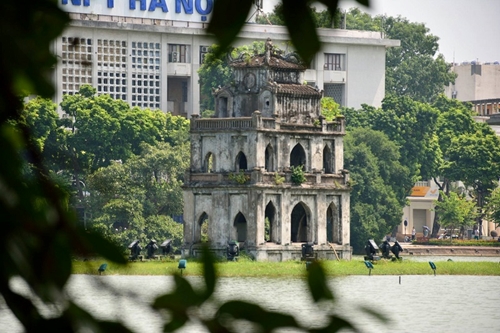 |
|
Turtle Tower in the middle of Hoan Kiem Lake in the Old Quarter of Hanoi (Photo: Huu Duong) |
Visitors to the CBD are advised to experience the nightlife there at the weekend and enjoy Bia Hoi (local draft beer) on Ta Hien street. There are so much more to enjoy apart from Bia Hoi, as the whole Old Quarter is now turned into walking streets starting 7 p.m. every Friday to the end of Sunday.
Just catch a bus or a taxi to the Old Quarter at the center of the city and enjoy the weekend. Visitors may opt for staying the night in the Old Quarter because there are a good number of good hotels in the area.
    |
 |
|
Lanterns decorated on trees along the streets in the Old Quarter at night (Photo: Huu Duong) |
2. Ho Chi Minh Mausoleum, Presidential Palace and Ho Chi Minh Museum
The complex of Ho Chi Minh Mausoleum, Presidential Palace and Ho Chi Minh Museum is organized in a close circle, starting from the mausoleum and ending at the museum.
Situated in Ba Dinh square and the surrounding, this is one of the most visited attractions in Hanoi. The mausoleum is the final resting place of President Ho Chi Minh, the outstanding leader and national liberation hero of Vietnam, whose body is preserved here.
Meanwhile, the Presidential Palace is a yellow building with 30 rooms built in 1901 in the French architectural style, mostly used for political events now. President Ho Chi Minh used to receive international guests and Government’s officials there. However, he never lived in the palace but a small house-on-stilts nearby.
Taking the exit from the palace, travelers will go straight to Ho Chi Minh Museum where a lot of exhibits about the life and career of President Ho Chi Minh are displayed.
    |
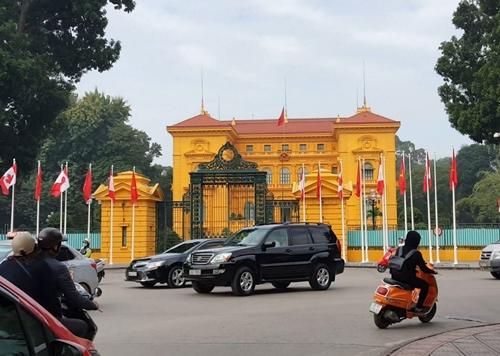 |
|
The Presidential Palace (Photo: Huu Duong) |
The mausoleum is closed on Monday and Friday. The palace is open to travelers all week except for Monday afternoon and Friday afternoon, while visitors can come to the museum from Tuesday to Sunday every week.
With the distance from the city’s center (Hoan Kiem Lake) of about 1km, most popular means of transport to the complex is taxi or Grab.
3. One Pillar Pagoda
One Pillar Pagoda is situated in the middle of the complex of Ho Chi Minh Mausoleum, Presidential Palace and Ho Chi Minh Museum. On the way from the Presidential Palace to Ho Chi Minh Museum, tourists may choose to briefly visit the pagoda before continuing with the tour to the museum.
    |
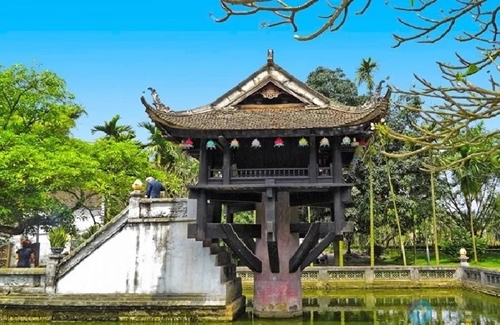 |
|
One Pillar Pagoda (Photo: dulichkhampha24) |
Legend has it that One Pillar Pagoda was built in the 11th century in the reign of King Ly Thai Tong of the Ly Dynasty. King Ly Thai Tong dreamt that Bodhisattva Avalokiteshvara gave him a son while resting on a lotus flower. He then got married to a peasant girl and gave birth to a baby boy.
To express gratitude to Bodhisattva Avalokiteshvara, the king built One Pillar Pagoda. In 1954, however, the French colonialists burned down the pagoda before leaving Vietnam. One year later, the government of Vietnam rebuilt the pagoda and it is the present pagoda that people often flock to visit and worship when visiting Hanoi.
4. Temple of Literature
The Temple of Literature is famous for being the worshiping place dedicated to Confucius. Built in 1070, six years later “Quoc Tu Giam” (Imperial Academy), was established inside the campus of the temple and is considered the first National University of Vietnam.
    |
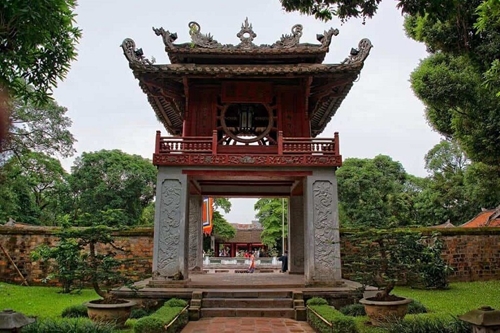 |
|
Temple of Literature (Photo: Getty Images) |
This ancient site is home to buildings bearing architectural features of the Ly and Tran dynasties and a place that has seen thousands of scholars and outstanding students graduating from schools then and universities now.
The site is well-preserved and is a typical example of traditional-style Vietnamese architecture, surrounded by picturesque landscapes. This timeless beauty spot is nearly 2km from Hoan Kiem Lake, which takes around 30 minutes to walk and about just 10 minutes to travel by car from the lake.
5. Vietnam Museum of Ethnology
The Vietnam Museum of Ethnology was built in 1995 and is the place where typical cultural features of Vietnam are displayed. It is in fact a great place for visitors keen on exploring the socio-cultural diversity of Vietnam to come to learn themselves.
    |
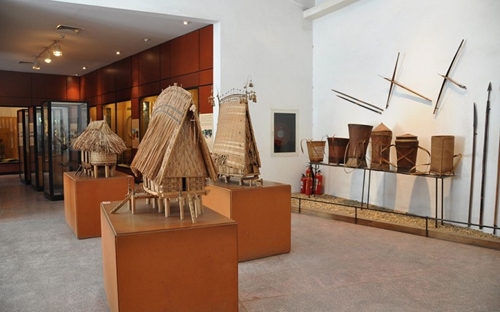 |
|
Vietnam Museum of Ethnology (Photo: foody.vn) |
The museum tells stories of the 54 ethnic groups of Vietnam through roughly 15,000 photos, video clips, and display items featuring the groups’ everyday life such as baskets, tables, clothes, etc. Rituals and ceremonies of each group are also specially displayed. What’s more, a virtual tour is also available.
Located on Nguyen Van Huyen street, Cau Giay district, about 6.5km from the city’s center, the Vietnam Museum of Ethnology is a must-see attraction for those who like to explore history and culture. Just only one thing noted: It is closed on Monday.
6. Hoa Lo Prison
Hoa Lo Prison (now Hoa Lo Museum) is located on Hoa Lo street in Hoan Kiem district, some 1.5km from the city’s center. It is now what is left from the original Hoa Lo Prison, which the French colonists used to detain Vietnamese political prisoners during the colonial period.
    |
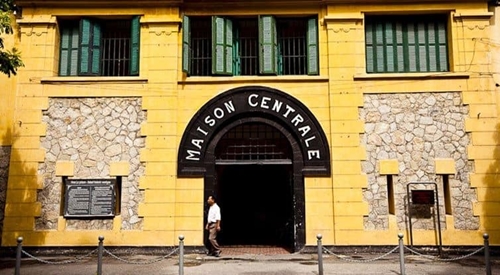 |
|
Hoa Lo Prison (Photo: Vntrip) |
Hoa Lo was not a successful prison then, as hundreds of revolutionaries managed to escape, especially through its sewage system under the ground. Now the living conditions of those detained during the colonial era are recreated in the museum in what used to be the prison those days.
If visiting the Old Quarter of Hanoi, visitors are advised to take a walk to Hoa Lo or just take a taxi (Grab) when tired of walking.
7. Thang Long – Hanoi Imperial Citadel
Thang Long - Hanoi Imperial Citadel is a UNESCO world heritage site. The site was excavated in 2004 and a number of artifacts as old as the 6th century such as bronze coins, ceramics, pottery, foundations of old roads and palaces, etc. were found.
    |
 |
|
Canons displayed in the citadel in the 70th celebration of the National Day (September 2, 1945 - 2015) (Photo: Huu Duong) |
The artifacts show the historical and cultural importance of Vietnam and its history. This is especially suitable for travelers who are interested in history, especially the four-thousand-year history of Vietnam, from the ancient to the modern history.
For its importance in the socio-political life of the Vietnamese people and all other historical, architecture values, the Imperial Citadel of Thang Long – Hanoi was made a UNESCO World Heritage Site in 2010. Apart from the remaining foundation of Kinh Thien Palace, coming to the site, visitors are advised to take a look at the notable attraction nearby in the Vietnam Military History Museum: The Hanoi Flag Tower.
8. Vietnam Military History Museum
The Vietnam Military History Museum, one of the seven national museums of Vietnam, is where authentic war relics and weapons used during the resistance war against U.S. invaders and soldiers’ keepsakes were displayed.
    |
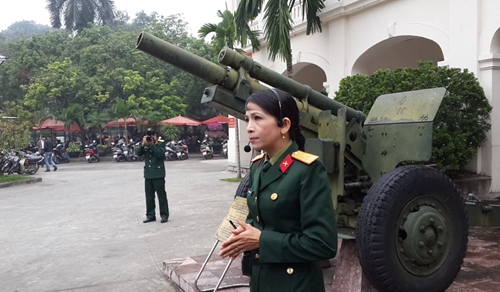 |
|
A tourist guide at the Vietnam Military History Museum (Photo: Huu Duong) |
Notably huge war materiel such as a MiG21 jet fighter, an M107 gun, a military tank and others were also exhibited. The museum is a well curated and well documented one for those interested in the war in Vietnam.
    |
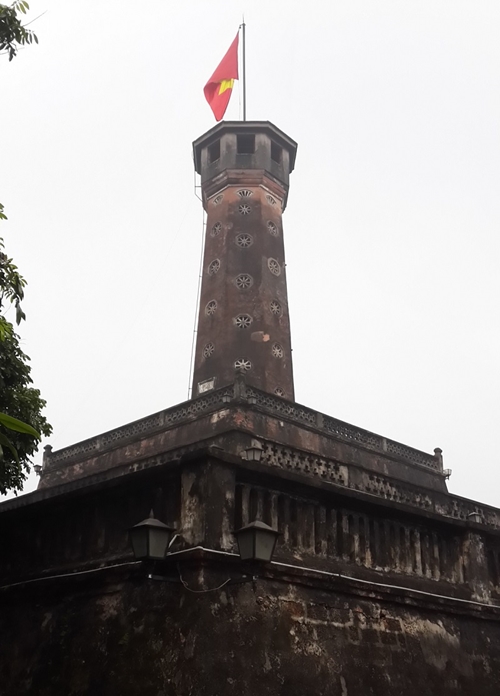 |
|
The flag tower inside the Vietnam Military History Museum (Photo: Huu Duong) |
The museum was inaugurated in 1959 and has collected, stored and displayed hundreds of thousands of artifacts. It is considered a holder of the history of war along the course of the thousands-of-years of history of Vietnam.
Huu Duong